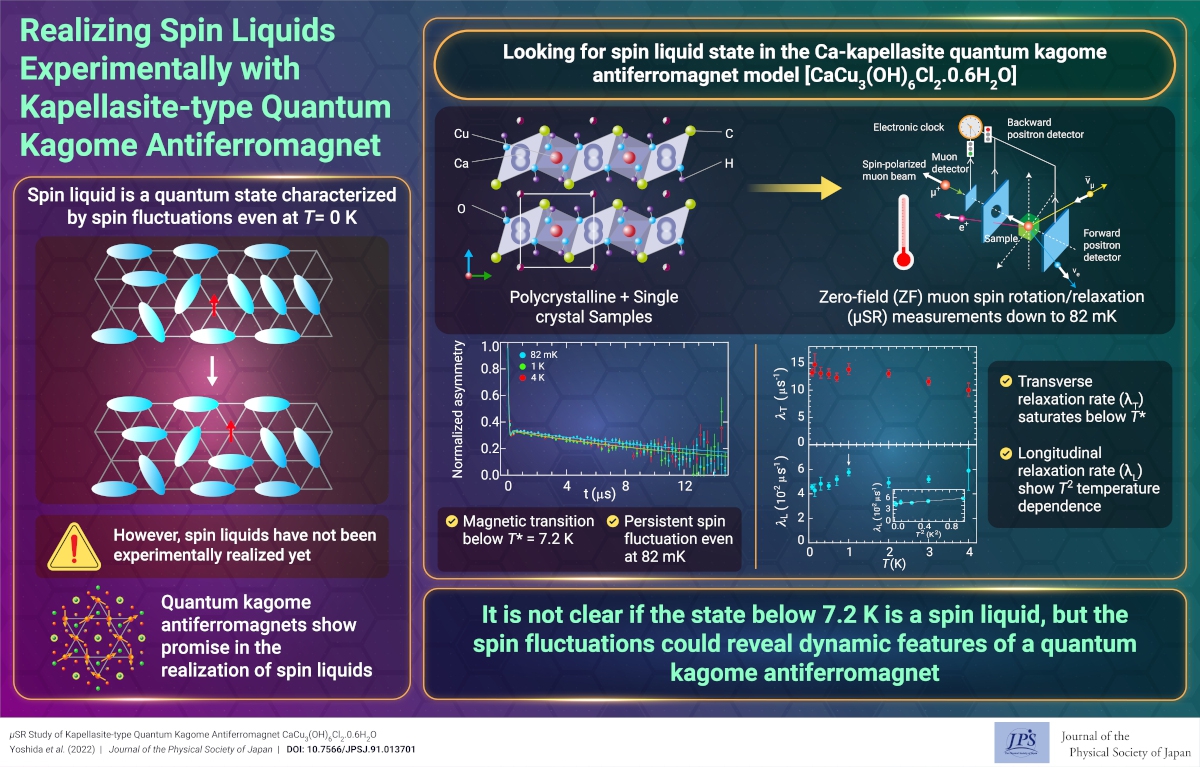Realizing Spin Liquids Experimentally with Kapellasite-type Quantum Kagome Antiferromagnet
© The Physical Society of Japan
This article is on
μSR Study of Kapellasite-type Quantum Kagome Antiferromagnet CaCu3(OH)6Cl2∙0.6H2O
(JPSJ Editors' Choice)
J. Phys. Soc. Jpn.
91,
013701
(2022)
.
This study reports the observation of the spin fluctuation in a quantum kagome antiferromagnet CaCu3(OH)6Cl2·0.6H2O which persists down to 82 mK using the μSR technique.

At ambient pressure, water has three states depending on the temperature; gaseous (water vapor), liquid (water), and solid (ice) states. Below 0 °C, water freezes to form ice which comprises crystals with molecules arranged periodically. Electron spins, which are responsible for the magnetism of materials, have similar thermodynamic properties. In general magnets, the paramagnetic (gaseous) state is stable at high temperatures in which the electron spins have random directions, whereas when the temperature is lowered, a phase transition occurs at a certain critical temperature to the magnetically ordered (solid) state in which the electron spins exhibit a periodical alignment. The magnetically ordered (solid) state is, for instance, a ferromagnetic state in which all the electron spins are aligned in one direction or an antiferromagnetic state in which all the neighboring spins point in opposite directions. By controlling and utilizing these magnetic states, modern electronics has progressed exponentially. Recently, the "magnetic frustration" effect, which prevents such electron spins from forming a solid state, has been actively investigated, and the realization and potential applications of the spin liquid state which is "a liquid state of electron spins" caused by the frustration effect have garnered significant interest.
In a spin liquid state, the spins continue to fluctuate without freezing even at absolute zero. The most famous model of the spin liquid state is the resonant valence bond (RVB) state proposed by Nobel laureate P.W. Anderson in 1973, and its relevance to the mechanism of high-temperature superconductivity and the feasibility of quantum computing using fractional excitations and associated quantum entanglement of the spin liquid state. Therefore, the realization and clarification of the spin liquid state is one of the most important issues in modern physics.
The authors have focused on Ca-Kapellasite (CaCu3(OH)6Cl2·0.6H2O) as a model material for a quantum kagome antiferromagnet, which has a strong frustration and is expected to be an excellent candidate for the spin liquid state. The spin dynamics of this material has been investigated in detail down to the extremely low temperature of 82 mK through the μSR technique. It has been elucidated from the magnetization measurements that Ca-Kapellasite exhibits magnetic order at 7.2 K. Therefore, it appears to be a magnetic material that can be described by the mean-field approximation of classical spin systems. However, the proposed μSR experiments revealed that the spins were fluctuating even in the magnetically ordered state. This indicates the dynamic aspect of the magnetic state of a quantum kagome antiferromagnet. It is expected that the development of chemically modified samples and related materials, as well as precise measurements of the physical properties, will significantly advance the understanding of the physics of kagome spin liquids.
(Written by H. K. Yoshida on behalf of all authors)
μSR Study of Kapellasite-type Quantum Kagome Antiferromagnet CaCu3(OH)6Cl2∙0.6H2O
(JPSJ Editors' Choice)
J. Phys. Soc. Jpn.
91,
013701
(2022)
.
Share this topic
Fields
Related Articles
-
Higher-Order Topological Phases in Magnetic Materials with Breathing Pyrochlore Structures
Electronic structure and electrical properties of surfaces and nanostructures
Magnetic properties in condensed matter
Mathematical methods, classical and quantum physics, relativity, gravitation, numerical simulation, computational modeling
2025-4-7
A simple example of a higher-order topological phase, in which the symmetry decreases step-by-step from the bulk to the corner, is realized in a magnetic system with a pyrochlore structure and is characterized by a series of quantized Berry phases defined for the bulk, surface, and edge.
-
Existence of Chiral Soliton Lattices (CSLs) in Chiral Helimagnet Yb(Ni1-xCux)3Al9
Magnetic properties in condensed matter
2025-4-1
Our study examines the magnetic structure of the monoaxial chiral helimagnet Yb(Ni1-xCux)3Al9, providing first direct evidence of the formation of chiral soliton lattice state.
-
Understanding Pressure-Induced Superconductivity in CrAs and MnP
Magnetic properties in condensed matter
2025-3-10
This study reviews existing research on the pressure-induced variation of magnetic properties of transition metal mono-pnictides like CrAS, MnP, and others, aiming to understand the unconventional superconductivity observed in CrAs and MnP.
-
Symmetry and AI: Building the Future of Physics Simulations
Magnetic properties in condensed matter
Measurement, instrumentation, and techniques
2025-2-18
Generative artificial intelligence (AI) has gained considerable attention in scientific fields. By embedding physical symmetry into AI before training, we created a faster and lighter model. Scaling improves the accuracy and unlocks the potential of physics research and applications.
-
Triangular Lattice Magnet GdGa2: Spin Cycloids and Skyrmions
Cross-disciplinary physics and related areas of science and technology
Electronic transport in condensed matter
Magnetic properties in condensed matter
2025-2-3
Careful measurements were conducted on the hexagonal magnet GdGa2 to reveal the experimental signatures of ultrasmall spin cycloids and of a potential Néel-type skyrmion lattice phase induced by a magnetic field.




